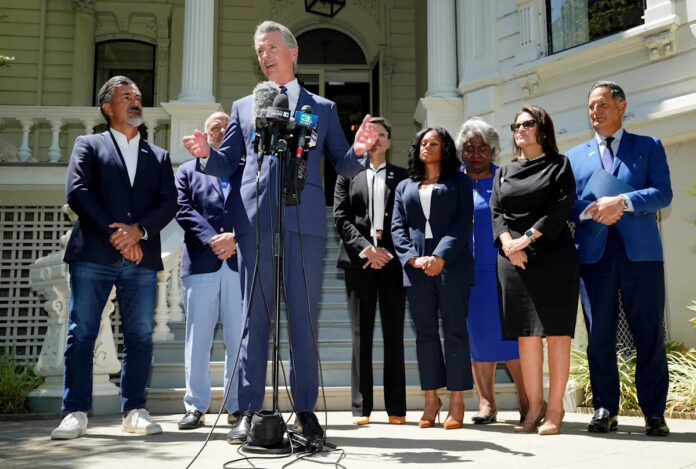Gavin Newsom’s push for a Democrat-boosting gerrymander of California’s congressional districts would have to run through the state Legislature — where it could collide with lawmakers’ career plans.
Few prizes tantalize term-limited state lawmakers quite like a safe House seat that’s effectively a lifetime gig. But returning to a bygone era of redistricting hardball could complicate life for ambitious incumbents redrawing the seats they hope to one day represent. California voters chose in 2010 to sideline self-interested politicians from the map-making process; restoring their role, as the governor wants to do, reopens some of those old incentives.
“I’ve seen the negotiations. I’ve seen all the arm-twisting that Willie (Brown) and Phil Burton had to do,” said Bruce Cain, who helped craft maps for the former Democratic leaders. Burton, he added, “had to browbeat people into things they wouldn’t want to do.”
For now, California Democrats are publicly rallying behind a national push to counter a similar effort led by the GOP in Texas. Even frontline House members are saying Democrats have to be armed with every option.
But it’s one thing to proclaim your support for a plan embraced by party grandees like Newsom and Minority Leader Hakeem Jeffries. Getting 54 Assembly votes and 27 Senate votes for new maps is a different matter. Some of the Democrats who will be asked to vote for the gambit will have to balance personal plans and party priorities.
Rarely does a vote in the state Legislature so directly tie into national politics or draw in national figures.
Some career ambitions are an open secret: State Sen. Scott Wiener’s run to replace Rep. Nancy Pelosi is only a matter of when Pelosi retires, and Speaker Robert Rivas is widely seen as a contender to replace Rep. Zoe Lofgren when she exits. A half-dozen other House Democrats sitting on safe seats around the state are in their 70s or 80s.
Then there are people actively campaigning for a promotion, like Assemblymember Jasmeet Bains, who’s running to unseat GOP Rep. David Valadao in a seat that could soon look very different (and that Valadao has held onto despite a sturdy Democratic edge).
Caveats apply: Newsom has only talked about redoing House seats, not the Legislature’s, which would spare incumbents being drawn into the kind of clashes with colleagues we saw repeatedly in 2022. Congress’ lack of a residency requirement could spare people moving costs (or FBI probes). The current nonpartisan process still yielded crowded, multi-incumbent Democratic primaries like the brawl for ex-Rep. Adam Schiff’s seat.
And there’s a specific type of state lawmaker whose options would be affected: one who overlaps with a safe House seat, held by a member nearing retirement, that is close enough to a Republican seat to be affected by its redraw. That’s a limited universe — solidly blue seats with octogenarian incumbents, like Pelosi’s, may not shift much.
“You might have a situation where 90 percent of voters are going to be in their same district,” said redistricting guru Paul Mitchell.
The legal pathway: Meanwhile, he potential contours of a snap California redistrict are coming into focus.
Attorney General Rob Bonta suggested Tuesday that lawmakers could put a new, fully realized map before voters for up-or-down approval. ”I think that’s what’s being contemplated here, and I think that’s what the legal pathway is,” Bonta told reporters, noting he’d been in touch with Newsom’s office. (Bonta’s office would write the ballot initiative’s official title and summary.)
Newsom has said he’s reviewing three or four options to proceed, including simply having the Legislature draw lines on the theory it retains the authority to do so despite California’s independent commission. But Bonta’s remarks suggest a special election could be the smoothest path — though it would still be a bumpy one.
Governors have a way of getting what they want — particularly when they’re rowing alongside the national Democratic apparatus — and Newsom’s message of confronting and countering Republicans has resonated with plenty of Democrats. But the changes Newsom is seeking may compel incumbents to dust off their contingency plans.
“Every day,” said Susannah Delano, head of Close the Gap, which recruits women to run for elected office, “is a good day for succession planning.”
Like this content? Consider signing up for POLITICO’s California Playbook newsletter.



